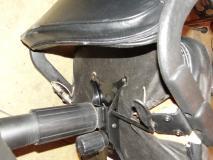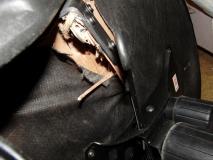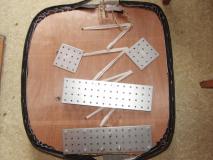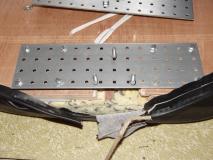Repair - armchair
Problem
There was an armchair. It had some years of service, including a lot of reclining.
There was a built-in support in the mounting assembly for the seat, where a spring was
located that facilitated a degree of reclining when the user leaned back.
The backrest and armrests were connected together to one structure. This structure was
attached to the seat. The seat was a 1-cm thick plywood board, with integrated metal nuts
for bolts holding the seat to the undercarriage and the armrests-backrest to the seat.
During reclining, all the bending force was focused to two triads of nuts, located
relatively close together. The high stress concentration, coupled with the cyclical nature
of the stress, led to material fatigue - delamination of the plywood. One day the plywood
gave way.
Solution
After analysis of the nature of the fault a repair approach was chosen. The broken parts
of the plywood were bridged over by a metal board, with built-in studs for the Z-plates for the
armrests.
2mm thick perforated steel boards, used for connection of wooden trusses, were chosen as a
relatively inexpensive, commercially readily available material.
Long-strip boards was used for each armrest mount, with a square board on each its end. The square
boards were used as grips for the plywood, putting it in compressive stress to prevent
further delamination and to act like overgrown washers.
Three holes were drilled into each long board in a triangle matching the holes in the armrest
mountpoints. M6 threads were cut in them and M6 bolts were placed in.
Mounting holes were drilled to the plywood seat, 4 on each side of the strip, using the strip
as a drill guide. Bolts were placed into the drilled holes in order to keep the board in place
and avoid shifting and subsequent hole misalignment.
M5x25 hex-head bolts were chosen for joining the strip and the squares. The squares were slid between
the polyurethane cushioning layer on the seat and the plywood base. Bolts were inserted through the
strip-plywood-square sandwich, nuts were placed on them (a fairly difficult operation, using touch).
The sandwich structures were tightened using a wrench. The armrest holding adapters were placed on the
protruding M6 bolts and attached with nuts.
The chair was then reassembled and the upholstery, partially removed to gain access to the upper side
of the plywood board, was nailed back in place.
Load tests shown no deformation nor other degradation of the repaired structure.
Images

Broken chair | 
Broken chair, detail | 
Delamination detail | 
Delamination detail |

Metal parts | 
Position of armrest-mounting board | 
Holes for armrest-mounting board, detail of delamination | 
Armrest mounting boards in place |

Armrest screws detail | 
Sandwich attachment | 
Armrest mounting plates, attached | |
| If you have any comments or questions about the topic, please let me know here: |










